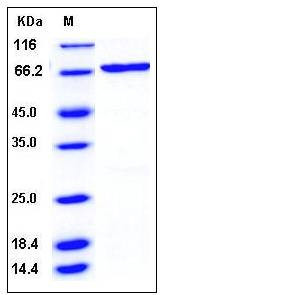Human SGK3 / SGKL Protein (His & GST Tag)
CISK,SGK2,SGKL
- 100ug (NPP4264) Please inquiry
| Catalog Number | P11733-H20B |
|---|---|
| Organism Species | Human |
| Host | Baculovirus-Insect Cells |
| Synonyms | CISK,SGK2,SGKL |
| Molecular Weight | The recombinant human SGK3/GST chimera consists of 733 amino acids and has a calculated molecular mass of 85 kDa. It migrates as an approximately 68 kDa band in SDS-PAGE under reducing conditions. |
| predicted N | Met |
| SDS-PAGE |  |
| Purity | > 96 % as determined by SDS-PAGE |
| Protein Construction | A DNA sequence encoding the human SGK3 (Q96BR1-1) (Met 1-Leu 496) was fused with the N-terminal polyhistidine-tagged GST tag at the N-terminus. |
| Bio-activity | No Kinase Activity |
| Research Area | Signaling |Signal Transduction |Protein Kinase |Intracellular Kinase |Other Intracellular Protein Kinases |
| Formulation | Lyophilized from sterile 20mM Tris, 500mM NaCl, 0.5mM PMSF, 10% gly, 1mM GSH, pH 7.4 1. Normally 5 % - 8 % trehalose, mannitol and 0.01% Tween80 are added as protectants before lyophilization. Specific concentrations are included in the hardcopy of COA. |
| Background | Serine / threonine-protein kinase Sgk3, also known as Serum / glucocorticoid-regulated kinase 3, Serum / glucocorticoid-regulated kinase-like and SGK3, is a cytoplasmic vesicle protein which belongs to the protein kinase superfamily and AGC Ser/Thr protein kinase family. SGK3 contains one AGC-kinase C-terminal domain, one protein kinase domain and one PX (phox homology) domain. Two specific sites of SGK3, one in the kinase domain (Thr-320) and the other in the C-terminal regulatory region (Ser-486), is needed to be phosphorylated for its full activation. SGK3 is expressed in most tissues with highest levels in pancreas, kidney liver, heart and brain and lower levels in lung, placenta and skeletal muscle. SGK3 is involved in the activation of potassium channels. It mediates cell IL-3-dependent survival signals. SGK3 participates in the regulation of HERG by increasing HERG protein abundance in the plasma membrane and may thus modify the duration of the cardiac action potential. SGK3 is also a very important and characteristic molecule that plays a critical role in both hair follicle morphogenesis and hair cycling. |
| Reference |
